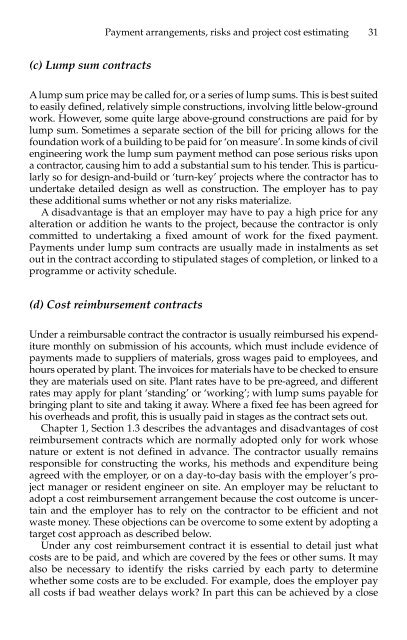Civil Engineering Project Management (4th Edition)
You also want an ePaper? Increase the reach of your titles
YUMPU automatically turns print PDFs into web optimized ePapers that Google loves.
(c) Lump sum contracts<br />
Payment arrangements, risks and project cost estimating 31<br />
A lump sum price may be called for, or a series of lump sums. This is best suited<br />
to easily defined, relatively simple constructions, involving little below-ground<br />
work. However, some quite large above-ground constructions are paid for by<br />
lump sum. Sometimes a separate section of the bill for pricing allows for the<br />
foundation work of a building to be paid for ‘on measure’. In some kinds of civil<br />
engineering work the lump sum payment method can pose serious risks upon<br />
a contractor, causing him to add a substantial sum to his tender. This is particularly<br />
so for design-and-build or ‘turn-key’ projects where the contractor has to<br />
undertake detailed design as well as construction. The employer has to pay<br />
these additional sums whether or not any risks materialize.<br />
A disadvantage is that an employer may have to pay a high price for any<br />
alteration or addition he wants to the project, because the contractor is only<br />
committed to undertaking a fixed amount of work for the fixed payment.<br />
Payments under lump sum contracts are usually made in instalments as set<br />
out in the contract according to stipulated stages of completion, or linked to a<br />
programme or activity schedule.<br />
(d) Cost reimbursement contracts<br />
Under a reimbursable contract the contractor is usually reimbursed his expenditure<br />
monthly on submission of his accounts, which must include evidence of<br />
payments made to suppliers of materials, gross wages paid to employees, and<br />
hours operated by plant. The invoices for materials have to be checked to ensure<br />
they are materials used on site. Plant rates have to be pre-agreed, and different<br />
rates may apply for plant ‘standing’ or ‘working’; with lump sums payable for<br />
bringing plant to site and taking it away. Where a fixed fee has been agreed for<br />
his overheads and profit, this is usually paid in stages as the contract sets out.<br />
Chapter 1, Section 1.3 describes the advantages and disadvantages of cost<br />
reimbursement contracts which are normally adopted only for work whose<br />
nature or extent is not defined in advance. The contractor usually remains<br />
responsible for constructing the works, his methods and expenditure being<br />
agreed with the employer, or on a day-to-day basis with the employer’s project<br />
manager or resident engineer on site. An employer may be reluctant to<br />
adopt a cost reimbursement arrangement because the cost outcome is uncertain<br />
and the employer has to rely on the contractor to be efficient and not<br />
waste money. These objections can be overcome to some extent by adopting a<br />
target cost approach as described below.<br />
Under any cost reimbursement contract it is essential to detail just what<br />
costs are to be paid, and which are covered by the fees or other sums. It may<br />
also be necessary to identify the risks carried by each party to determine<br />
whether some costs are to be excluded. For example, does the employer pay<br />
all costs if bad weather delays work? In part this can be achieved by a close


















